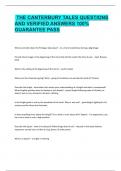The canterbury tales - Study guides, Class notes & Summaries
Looking for the best study guides, study notes and summaries about The canterbury tales? On this page you'll find 240 study documents about The canterbury tales.
Page 3 out of 240 results
Sort by
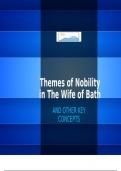
-
The Wife of Bath Context (The Canterbury Tales)
- Summary • 6 pages • 2024
-
- $6.64
- + learn more
A slideshow presentation on the context for “The Wife of Bath’s Tale and Prologue”, on the themes of gentility and female sovereignty. Suitable for the study of Chaucer’s “The Canterbury Tales”. Happy studying!
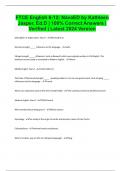
-
FTCE English 6-12: NavaED by Kathleen Jasper, Ed.D | 100% Correct Answers | Verified | Latest 2024 Version
- Exam (elaborations) • 19 pages • 2024
-
- $12.49
- + learn more
Old English or Anglo-Saxon. Years? - 450-1100 A.D. Romans brought _____ influences to the language. - Latin Vikings brought _____ influences. Such as Beowulf, which was originally written in Old English. The textbook version today is translated to Modern English. - Norse Middle English. Years? - A.D. The Duke of Normandy brought _____ -speaking nobles to run his new government, thus bringing _____ influences into the language. - French What is an important work of this time? () - The Can...
 Popular
Popular
-
Praxis 5047 Middle school english, Praxis 5047 ALL SOLUTION LATEST EDITION 2024 ALL 100% CORRECT GUARANTEED GRADE A+
- Exam (elaborations) • 44 pages • 2024 Popular
-
- $14.89
- 1x sold
- + learn more
Parable realistic and has a moral Legend exaggerated story about people Myth literary sub genre of a story that involves gods and heroes, usually expressing a cultures ideals Folktale language of the people, does not need a moral, and main purpose is to entertain Fairytales element of magic, usually follows a pattern, and presents an "ideal", may contain "magic 3" or "stereotyping" Fable non-realistic, has a moral, and animals are often the main character Fable Aesop- "The Fo...
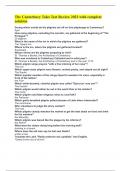
-
The Canterbury Tales Test Review 2023 with complete solution
- Exam (elaborations) • 6 pages • 2023
-
- $9.99
- + learn more
The Canterbury Tales Test Review 2023 with complete solution During which month do the pilgrims set off on this pilgrimage to Canterbury? April How many pilgrims, excluding the narrator, are gathered at the beginning of "The Prologue"? 29 pilgrims What is the name of the inn in which the pilgrims are gathered? The Tabard Inn Where is the inn, where the pilgrims are gathered located? Southwark Whose shrine are the pilgrims preparing to visit? St. Thomas a Becket, the Archbishop of C...
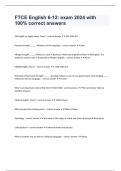
-
FTCE English 6-12: exam 2024 with 100% correct answers
- Exam (elaborations) • 19 pages • 2024
-
- $16.49
- + learn more
Old English or Anglo-Saxon. Years? - correct answer 450-1100 A.D. Romans brought _____ influences to the language. - correct answer Latin Vikings brought _____ influences. Such as Beowulf, which was originally written in Old English. The textbook version today is translated to Modern English. - correct answer Norse Middle English. Years? - correct answer A.D. The Duke of Normandy brought _____ -speaking nobles to run his new government, thus bringing _____ influences into the langua...
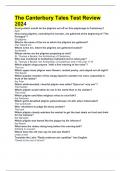
-
The Canterbury Tales Test Review 2024
- Exam (elaborations) • 6 pages • 2024
-
- $14.49
- + learn more
The Canterbury Tales Test Review 2024 During which month do the pilgrims set off on this pilgrimage to Canterbury? April How many pilgrims, excluding the narrator, are gathered at the beginning of "The Prologue"? 29 pilgrims What is the name of the inn in which the pilgrims are gathered? The Tabard Inn Where is the inn, where the pilgrims are gathered located? Southwark Whose shrine are the pilgrims preparing to visit? St. Thomas a Becket, the Archbishop of Canterbury Who was murder...
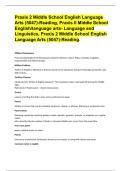
-
Praxis 2 Middle School English Language Arts (5047)-Reading, Praxis II Middle School English/language arts- Language and Linguistics, Praxis 2 Middle School English Language Arts (5047)-Reading.
- Exam (elaborations) • 27 pages • 2024
-
- $13.99
- + learn more
Praxis 2 Middle School English Language Arts (5047)-Reading, Praxis II Middle School English/language arts- Language and Linguistics, Praxis 2 Middle School English Language Arts (5047)-Reading. William Shakespeare Poet and playwright of the Renaissance period in Western culture. Plays, comedies, tragedies, tragicomedies and historical plays. William Faulkner Author of Southern literature in America based on his experience living in Mississippi during the early 20th century. Geoffrey Chau...
The Canterbury Tales
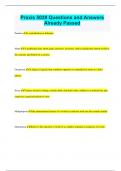
-
Praxis 5039 Questions and Answers Already Passed
- Exam (elaborations) • 27 pages • 2024
- Available in package deal
-
- $9.99
- + learn more
Praxis 5039 Questions and Answers Already Passed Paradox a contradiction or dilemma Myth A traditional story about gods, ancestors, or heroes, told to explain the natural world or the customs and beliefs of a society. Oxymoron A figure of speech that combines opposite or contradictory terms in a brief phrase. Essay A piece of prose writing, usually short, that deals with a subject in a limited way and expresses a particular point of view. Malapropism the unintentional misuse...
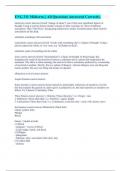
-
ENG 311 Midterm || All Questions Answered Correctly.
- Exam (elaborations) • 26 pages • 2024
-
Available in package deal
-
- $13.99
- + learn more
metonym correct answers (Greek "change of name"): one of the most significant figures of thought. Using a word to denote another concept or other concepts, by virtue of habitual association. Thus "The Press," designating printed news media. Fictional names often work by associations of this kind; substitute something with association synecdoche correct answers (Greek "to take with something else"): a figure of thought. Using a part to express the whole, or vice versa, e.g. "all hand...

How did he do that? By selling his study resources on Stuvia. Try it yourself! Discover all about earning on Stuvia



